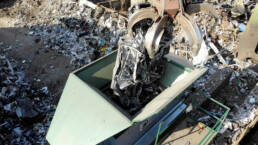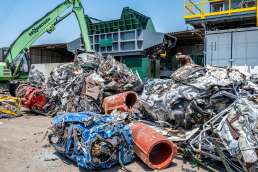End-of-life vehicle recycling: trends and perspectives for the industry
Every end-of-life vehicle can become a new resource. In this article, we explore how the evolution of ELV recycling is transforming the industry.

Every year around 40 million vehicles worldwide reach the end of their life cycle. A continuous flow of materials that, if managed correctly, can be transformed from complex waste to a strategic resource for the circular economy. In Europe, where more than 6 million vehicles are dismantled every year, the Directive 2000/53/EC requires that at least 95% of each vehicle’s weight be recovered, with a minimum target of 85% for actual recycling. An ambitious goal that calls for increasingly advanced technologies and an industrial vision focused on sustainability and process efficiency.
What you can really recycle from a car
According to analyses of passenger vehicles, a modern car is composed on average of 75% metals, 15% plastics, and the remainder of glass, rubber, fluids and electronic components. Ferrous metals are efficiently separated through shredding and magnetic sorting, while the recovery of non-ferrous metals, such as copper, aluminium and brass, requires more complex refining and separation processes. However, not everything that remains after shredding can be put to immediate use. As a matter of fact, the treatment generates a light fraction called car fluff (or Automotive Shredder Residue – ASR), consisting of plastics, fibres, foams, rubber residues and small metal particles, which, due to its heterogeneous composition, is one of the main obstacles to reaching the recovery targets imposed by regulations.
In recent years, the evolution of technologies has made it possible to valorise this fraction as well, recovering additional quantities of metals and reducing the amount going to landfill. Solutions such as high-efficiency refining, densimetric and eddy-current separation, and even pyrolysis or energy recovery processes are transforming car fluff from complex waste to a complementary resource in the recycling process.
In parallel, the increase of electronic components and composite materials in modern cars makes it increasingly important to have processing systems capable of precisely handling mixed materials, cables, motors and technical plastics, ensuring selective separation and the maximum purity of the recovered metals.

The environmental and economic value of ELV recycling
Recycling a car is not just about reducing waste, but regenerating value and resources. Every tonne of recovered steel or aluminium saves large amounts of energy and reduces CO₂ emissions compared to production from virgin raw material, thus making a tangible contribution to a more sustainable industry. In Europe, around 90% of materials from end-of-life vehicles are nowadays reused or recycled, an achievement that testifies to technological progress and the increasing focus on the circular economy. In addition to its environmental benefits, the car recycling sector generates skilled employment, stimulates the search for new solutions, and fosters the creation of supply chains for metal recovery and the production of secondary raw materials, which are increasingly key to the competitiveness of the European industry.
From grinding to metal separation, technology plays a decisive role in making the treatment of end-of-life vehicles sustainable and profitable.
Industry trends and challenges
According to some estimates, the ELV recycling market was globally worth around $27.5 billion in 2023, with an expected growth of 6-7% per year until 2032. A dynamic and fast-moving sector, driven by three converging forces: technological evolution, energy transition and regulatory pressure. In this scenario, ELV recycling is no longer an end-of-supply chain activity, but an integral part of the industrial strategy of the automotive sector, now at the core of new trends and challenges that will define its future.
TRANSITION TO AN ELECTRIC VEHICLE FLEET
With more than 14 million electric vehicles registered in 2023, the sector faces new challenges related to the management of complex components such as high-voltage batteries, permanent magnets and critical materials such as lithium, cobalt and rare earths. These elements require targeted processes of securing, treatment and selective recovery, capable of combining sustainability and profitability.
AUTOMATION AND DIGITALISATION
The heart of innovation is increasingly moving towards smart process management in new-generation systems, advanced sensor technology, machine vision and real-time data analysis enable optimisation at every stage of treatment. The data-driven logic improves the quality of recovered metals and reduces error margins, paving the way for a more precise, efficient and measurable recycling model.
TOWARDS A ZERO WASTE LOGIC
The concept of zero waste is gradually replacing the linear view of recycling with a more circular concept, in which each vehicle component is recovered. This integrated approach requires increasingly close collaboration between system manufacturers, recycling operators and industries using secondary raw materials.
COPPER AND ALUMINIUM AT THE CORE OF THE TRANSITION
At the same time, global demand is growing for recycled aluminium and copper, central materials for electric mobility and sustainable industrial production. Europe, in particular, is aiming to become more autonomous in finding these resources, favouring investments and innovations that can make ELV recycling a strategic cornerstone of the circular industry.
Panizzolo solutions for the treatment of vehicle materials
In light of these dynamics, Panizzolo solutions offer a tangible contribution to the treatment and recovery of materials from end-of-life vehicles, combining high production performance, reduced management costs and ease of use.
The technologies embedded in our systems enable the acceleration of the metal recovery stages, guaranteeing flexibility in processing and the high quality of ferrous and non-ferrous metal output. The final recovery of ASR is completed through the refining end-of-waste, cycle process, fully compliant with environmental regulations and geared towards maximum economic yield, with an output suitable for direct sale to smelters. The treatment lines offer a productivity ranging from 7 to 35 tonnes/hour and can handle different types of materials, including end-of-life vehicles, car packs, car engines and ASR. Thanks to a modular design and established know-how, each system can be adapted to the operational needs of the customer, with a view to maximising recovery and investment. An approach that combines innovation, efficiency and sustainability, turning what was once waste into a valuable industrial resource.